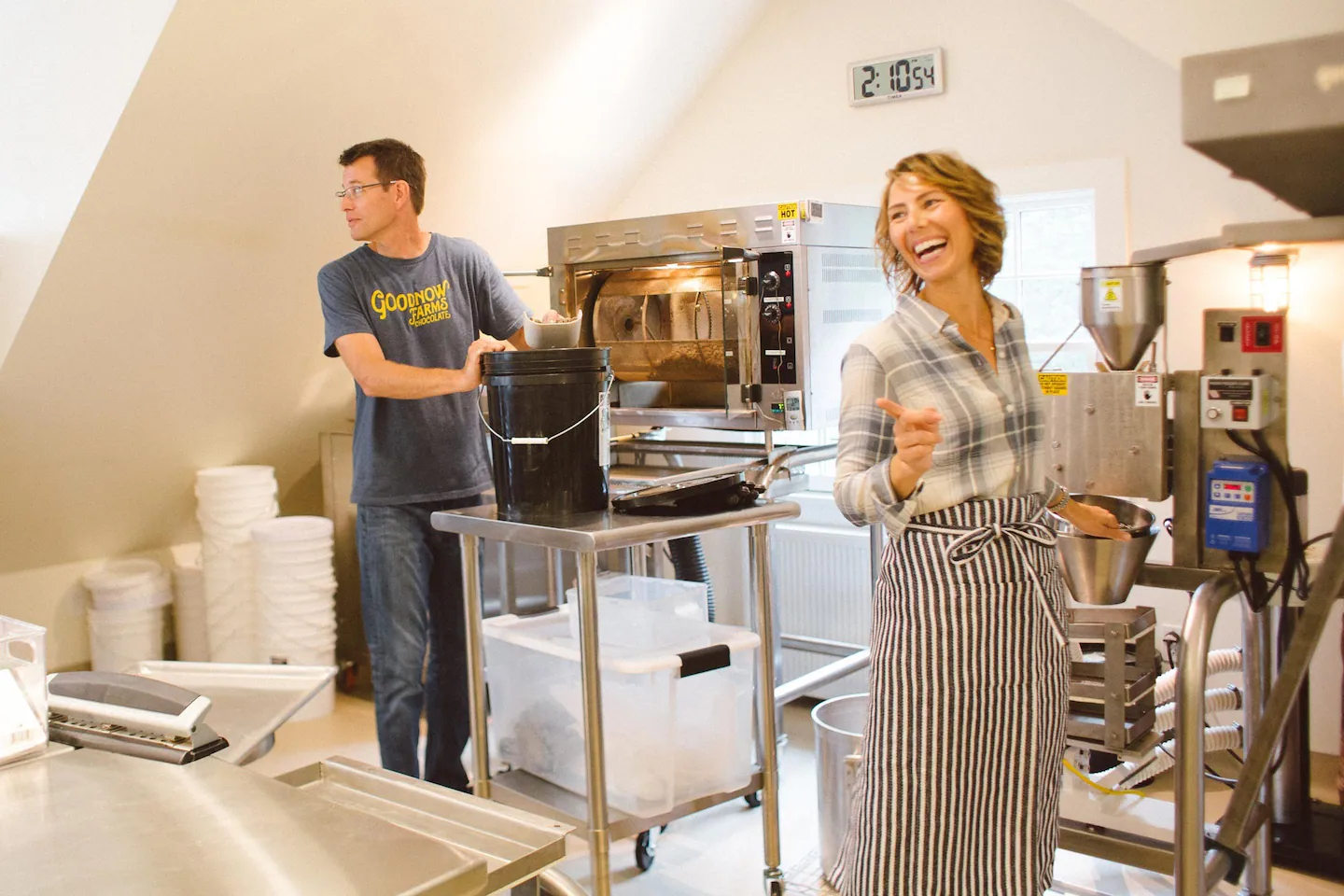Copyright The Boston Globe

Why did you and your husband decide to launch a chocolate business? As with everything in life, it was born out of frustration. We couldn’t find chocolate that we wanted on a regular basis, so we decided: Let’s get the seeds, and let’s try making it. We started doing that, and it was a hobby. We did it in our home kitchen, and I think that the first test batches really showed us that different bean types taste differently, just like wine grapes taste differently. That was just the beginning — and it was such a creative, fun hobby. Our neighbors were really nice to us and said that it tasted good, and it encouraged us to continue. I have two kids and a small kitchen. I would not begin to know how to make chocolate, nor would I be able to find the time. How did you actually do it? I lived in Central America when I was in my early 20s, in Panama, and I had cacao growing behind my home. I would love to go out and just eat the fruit from the tree. I didn’t know all the mechanics behind it when I lived there. All I knew was, I have cacao fruit, and it’s amazing. And I tried making chocolate once because I knew: Well, it comes from seeds, and you have to grind them up. It was a failed attempt, but it was fun. When we couldn’t get the chocolate that we wanted, I was thinking: We can get the seeds. We did a little research online — and this is before we were married, over 20 years ago, before we had kids. We had time on the weekends. I used to do real estate development and construction, and my husband was in entertainment, and it was a fun hobby that we could share together. We got beans. We got a Champion juicer to refine them even more, to decrease the particle size. The first chocolate that we made was super gritty, and the flavors weren’t as complex and developed. But, over time, you just experiment in your home oven. You roast at different temperatures, with convection, with air flow. It’s just a really fun process. There are a lot of people who are bakers as a hobby, who bake cakes and make macaroons. And there are people who like to make chocolate as a hobby, too, and that’s what we did. How did this go from hobby to business? We got married, started having a family, and were more mature in our careers. My husband sold his company. When he did that, we were talking about: Well, what do we want to do with our lives? Where are we now? Our families are from New England, and we were in Los Angeles at the time, and we really wanted to get closer to being with family and have a quality of life that was more family-focused, and to teach the kids about being entrepreneurs and what it’s like to grow your own business. So we had a plan: We were going to look for an old farmhouse outside of Boston. We wanted to be close to Boston, because of the cultural center and to have access to all the amazing things Boston has. But we wanted the space to be able to have nature and for the kids grow up in a community where there are really great public schools. In Sudbury, we found a gorgeous farmhouse that had the perfect building behind it that we knew we could turn into a commercial kitchen. We bought the farm, literally — and then we created a plan to gut the building and retrofit it with steel beams to create a commercial kitchen. We started building it, and it took us about a year. We knew we always wanted to have direct relationships with our farmers. We started reaching out to different farming groups in Central and South America and Mexico, looking for potential farming partners that farmed fine-flavor cacao. There are two different types of cacao: There’s commodity cacao that’s grown on a large scale, and it’s not necessarily grown for fine flavor and super high quality. They really want a more uniform product. The terroir really plays a big role in the flavor of the cacao. Then, after cacao is grown and harvested, farmers actually have to ferment it, and that plays a huge role in the flavor of the cacao, too. There’s a lot of time, effort, and value that goes into fine-flavor cacao. So we started looking for farmers — you talk to people; there’s a friend who knows a friend who has a farm. These are all small shareholder farmers. People don’t realize, for cacao, they only have three to six acres of land. And cacao trees … can just grow around their houses, in their villages. We went down to visit; we saw what they were doing. They were aligned with our vision: fine-flavor cacao, environmentally sustainable, safe working conditions, and long-term partnerships. We would pay for the value. We paid higher prices because of the value that was going in. We got superb beans, and we started crafting chocolate with it. Walk me through your day-to-day now. A Day in the Life of a Chocolate Maker in Sudbury: It sounds very bucolic. It is very cozy. It’s very beautiful, but it is a lot of hard work. You know, it’s my husband and me. We live in our house and our farm. We get up, get the kids to school, and then walk across the driveway and go into the chocolate factory. It’s in the building adjacent to our barn. We check to see how the chocolate is doing in the grinders. It takes about a week to two weeks to make a batch of chocolate. A batch of chocolate is about 1,400 bars. The reason why it takes so long is because all of the steps are really labor-intensive to make chocolate that actually tastes like a really good food. We don’t hide behind any additives. We really just maximize the flavor potential in the beans. What that means is you have to be really particular about roasting each bean the right way. You don’t want to over-roast. You want to just roast enough to bring out the natural flavor compounds that are going to make the best chocolate. And then, after you roast them, you have to take off the shells, the husks. After you take off the husks, then you can put the beans in the large grinders. We use large stone grinders, which decreases the particle size so that you don’t taste the particle grittiness on your tongue. It also aerates the molecules so that different flavor compounds combine. It’s called the conching process. You can do a ton of flavor development with roasting and conching and grinding. The other really important step is we freshly press our own cocoa butter, supplemental cocoa butter that we add to our chocolate. You only need cacao beans and sugar to make chocolate, but what we found is that, when we just used cacao beans and sugar, the chocolate was dry or chalky. We roast additional single-origin beans for whatever origin we’re making in that chocolate, and then we compress the beans and press out the fat into golden, delicious cocoa butter ... that supplemental butter really retains the flavor of the bean. After about five or six days in the grinder, we take it out and pour it into the tempering machine, and we make our bars. After you make the bars, you have to hand-wrap them. Sometimes, you lose a couple in the process to taste-testing; it depends on if I’m wrapping the bars or not. What about your kids? My kids are professional chocolate taste-testers. They’re 11 and 13, and they do help out. They wrap the chocolate bars, and they love it, because they earn extra spending money. What’s it like to work with your spouse? Are you chatting over the chocolate grinder? This was very intentional. Both my husband and I are creative and entrepreneurial, and there are things that he’s really good at, where I lack, and things that I’m really good at, which he appreciates. So there is division of labor, but there’s a lot of overlap, because this is a really creative process. It’s really scientific and creative, and you need both. He does a lot with operations and management. We do taste-testing together. We develop flavors together. He’s got flavor combinations that he champions. I’ve got flavor combinations that I champion. I’m always looking at ways to optimize things. My background is in manufacturing engineering. I’m a super science geek. I love understanding how flavors develop and looking at the different parameters for how to change variables, to get different things to happen in different ways. The reality is: You have to divide things up, but we always come back together to make sure we’re on the same page. We do our own thing and check in a couple times a week to make sure that we’re all good. What are your favorite flavors, and what are his? This is a really tough one. Our Green Sichuan Pepper bar is one of my favorites. It’s super funky. People don’t realize that green Sichuan is a berry. It’s not a pepper; it’s the skin of a berry. And there’s this oil in the skin that causes your tongue to tingle. It’s delicious and refreshing and herbal and tingly and little zesty. It’s a flavor journey. I love the experience of that. Every morning he has a Cafe con Leche bar for breakfast. It’s butterscotchy, with chocolate-y coffee notes. It’s so nice. That sounds like a wonderful breakfast. Civilized. The thing is, people don’t realize chocolate doesn’t have to be sugary, sweet candy. Chocolate comes from seeds. It can be a food, and that’s what we make. We make a food that retains its natural nutrients. We don’t strip it of anything in the industrial processes. I’m very envious as I look at my banana and yogurt. Is your house going to be the most popular one on Halloween? Do people raid your chocolate factory? Well, actually, what we do is plan ahead. We have haunted barn parties annually. Every year, we decorate our barn, totally trick it out with spooky decorations, animatronics, lighting. We just had our haunted barn party last weekend, where the public was able to buy tickets, and it was a really fun party. Below the barn, in the basement, we had Boston Harbor Distillery with their bar and Concord Market with all of their sweet and savory treats. That’s really a big celebration for us. And then we had our chocolate bars, where people had unlimited tastings. It was a really special, fun time. What’s your guilty vice snack? I’m going to sound like such a wet rag, but I don’t believe in guilty vices. Let’s take out the guilt: What do you snack on? I eat chocolate every day. Right now I’m eating our Nantucket Fog bar, which is delicious. I love it. It’s a dark milk bar with Earl Grey tea and bergamot. So that’s a fun one. Do your kids eat a lot of chocolate, or are they jaded? We’ve always told our kids that chocolate is a growing food, and they can have our chocolate whenever they want it. Our daughter goes out to the chocolate factory every morning before biking to school, and she grabs a bar or two, and she eats it, and she shares it with friends. That’s just a regular thing. And they love the sugary stuff. You know, it’s fun. Sure, everyone loves sugar, so they’ll have treats. But, you know, for chocolate, I think they really appreciate what we make. Interview was edited and condensed.



